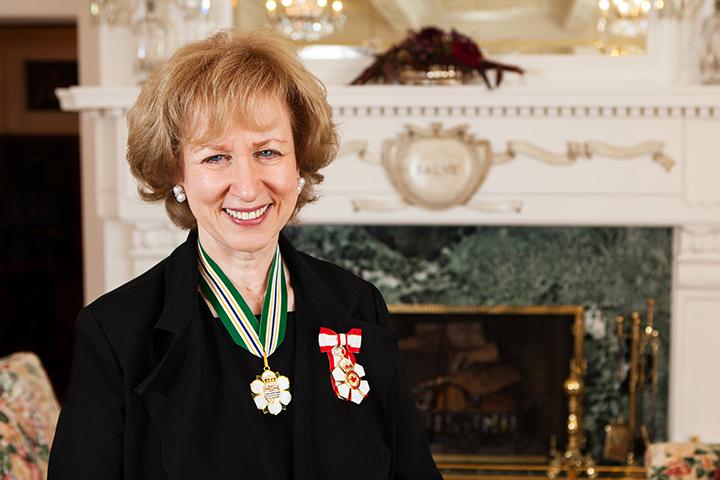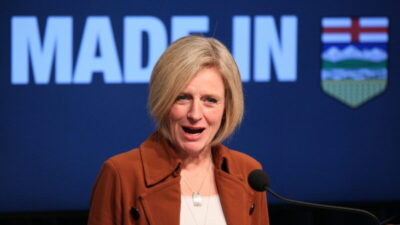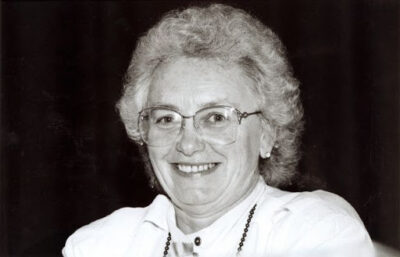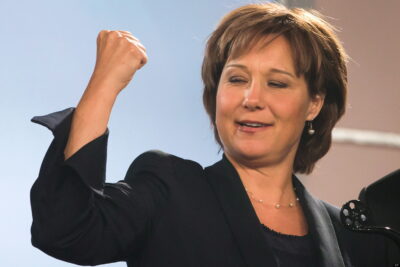1034 Women trailblazing in politics
Doing Politics Differently? Women Premiers in Canada’s Provinces and Territories
by Sylvia Bashevkin (editor)
Vancouver: UBC Press, 2019
$34.95 / 9780774860819
Reviewed by Barbara J. Messamore
*
 Do women “do politics differently?” Not so much. That said, it is not at all clear that we need even ask the question “is it worth electing more women to public office?” (p. 296) Women are not obligated to be elected as advocates of women’s interests in particular; nor is “the symbolic value of seeing women in top leadership positions” (p. 296) paramount. The issue is one of simple justice: women have an inherent right to full participation, whatever their views.
Do women “do politics differently?” Not so much. That said, it is not at all clear that we need even ask the question “is it worth electing more women to public office?” (p. 296) Women are not obligated to be elected as advocates of women’s interests in particular; nor is “the symbolic value of seeing women in top leadership positions” (p. 296) paramount. The issue is one of simple justice: women have an inherent right to full participation, whatever their views.
Given the proliferation of women leaders at the sub-national level in recent years, Doing Politics Differently? is timely. At one juncture, Sylvia Bashevkin notes, “half of Canada’s provinces and nearly 90 percent of the country population were governed by female premiers” (p. 4). By contrast, in the United States, the number of women state governors hit a peak at 9 of 50 in 2004-2007 (p. 6).
One of the book’s main areas of analysis concerns the extent to which women leaders advanced the cause of women as candidates and as legislative and cabinet members, and the extent to which their legislative agenda prioritized women’s issues. Some of the individual authors in this collection have ventured beyond that question, providing a fuller measure of these women’s achievements. As the contributing authors acknowledge, “executive agendas can be profoundly shaped by the turbulent times in which premiers govern” (p. 133).



The book offers a valuable analytical framework to assess the circumstances in which these women came to power. Some attained office in times of what Bashevkin calls “imperilled leadership” (p. 5), the classic Kim Campbell-type scenario in which a woman is handed the helm of a sinking ship. Other female leaders considered are examples of “empowered leadership,” an apparently advantageous situation in which a woman takes over the leadership in the wake of a popular retiring premier. Contributor Tracy Summerville observes that newly appointed female premiers appear to fare better electorally when they have had a significant time in office before facing election (p. 280). The third scenario is one of “pioneering” leadership, in which a woman leads a formerly weak opposition party to power. Alberta NDP Premier Rachel Notley (2015-2019) is a case in point. Each of these dynamics carries with it some element of risk, and the book analyzes how these might play out.

Although the metaphor of the “glass cliff” has been applied in cases of “imperilled leadership,” the book’s contributors offer several examples in which the low expectations for subsequent party success proved inaccurate. As Bashevkin notes, “these women rank as political heroes since they rescued their organizations from what seemed like certain political oblivion” (p. 11). Pauline Marois assumed leadership of the struggling Parti Québécois in 2007 — a party that looked like a “tired” relic of the 1970s and faced competition from new parties (p. 168) — and won a minority government in 2012. Alison Redford won Alberta’s Progressive Conservative leadership in 2011 and a majority government the following year, a surprising win given her predecessor’s declining popularity. Redford came from a Red Tory tradition, and campaigned against her own party’s record, vowing to restore education cuts (p. 227). Her ability to portray the less moderate Wild Rose party as a threat also paid dividends (p. 282). Kathleen Wynne’s Ontario Liberal predecessor, Dalton McGuinty, had been mired in controversy. Wynne won the leadership race in 2012 and a majority government in the 2014 election. BC Liberal leader Christy Clark, who succeeded a struggling Gordon Campbell in 2011, increased her party’s majority in the 2013 election.

Conversely, female leaders who seemed to have an easier route by following premiers with a strong support base often contrasted poorly with charismatic predecessors. Catherine Callbeck was a businesswoman whose 1993 elevation to PEI’s premiership after Joe Ghiz’s retirement was termed a “coronation” (p. 112). But PEI’s struggle with debt reduction, which included deep budget cuts and the breaking of union contracts brought plummeting popularity. Callbeck resigned in the fall of 1996, with her party defeated in the election that followed. Kathy Dunderdale won leadership of Newfoundland and Labrador’s Progressive Conservative party, with the unenviable task of filling Danny Williams’s “large boots” (p. 133) and won a subsequent, although slightly reduced, majority government in 2011.

But the very identification of the province’s PC party with the popular Williams threw Dunderdale’s “dreadful” communications style into sharp relief. Dunderdale’s delay in summoning the House of Assembly and thwarting of scrutiny of the Muskrat Falls hydroelectric project created an impression of an “imperious” premier dismissive of the democratic process (pp. 142-43). Dunderdale resigned abruptly after a “train wreck” television appearance in January 2014, and her party went down to defeat in the 2015 election, “hoisted by its own post-Williams petard” (pp. 144-45). Sometimes, contributing authors speculate, party insiders and backroom operatives maneuvered struggling women premiers from power.

One of the most interesting features of the book is the light it sheds on territorial government in the North for readers who may be unfamiliar with the different conventions that apply. Refreshingly, this section is not an afterthought, but placed at the beginning of the book. Nunavut and the Northwest Territories operate on a consensus government model, rather than a party system, with the speaker, premier, and ministers selected by MLAs in a secret ballot. The system carries with it its own challenges, notably the inability of the premier to select her own cabinet. The effect is one of “permanent minority status,” as Graham White puts it (p. 41). This dynamic shaped the terms both of Nellie Cournoyea, premier of the Northwest Territories from 1991 to 1995, and Eva Aariak, premier of Nunavut from 2008 to 2013.
For each of these pragmatic and inclusive women, the consensus model was a better fit with their own Aboriginal culture than traditional political warfare. Contributor Sheena Kennedy Dalseg describes Aariak as less ego-driven than conventional politicians (p. 93). Cournoyea explained that her mother’s Inuvialuit society valued “curiosity, resourcefulness, patience, kindness, and ability, … and appreciated …[those] who are responsible, who keep their word, and who are modest” (p. 35). While Cournoyea’s modesty led her to encourage the use of her first name, it nevertheless rankles to see “Premier Nellie” in print. How readily we fall into that pattern in reference to women!

Contributing authors consider the degree to which gender stereotypes hampered these women leaders. In some cases, it was discouragingly blatant. While Yukon Premier Pat Duncan was in opposition, NDP tourism minister Dave Keenan scolded her in response to her legislative questions: “This is not a little hen session around a coffee table, my dear” (p. 65). Duncan also remembered that female members faced criticism centred around their weight and appearance. (p. 72). Aariak’s consultative approach was attacked by critics as weak and naïve (p. 86). Media portrayals of Kathy Dunderdale were often gendered, presenting her as a matronly scolding schoolteacher (p. 147). Similar judgements were made of BC’s Rita Johnston (p. 210).

Numerous examples show that expectations that female leaders will prioritize women’s issues must be tempered. Just as leaders such as Aariak and Cournoyea sought to accommodate Aboriginal values, Pauline Marois’s PQ agenda focused on Québécois nationalism, including a secularist charter that many feminist groups opposed as exclusionary. Clark Bannock’s speculation that reduced numbers of women in caucus and cabinet under Alison Redford could “reflect… a ‘Queen Bee syndrome,’” is unfortunate. Myriad factors enter in to such decisions, and this summation is unwarranted (p. 234). He describes Redford as “constrained by the traditional ideological commitments of the PC party” (p. 238). Tracy Summerville makes the same point in reference to BC’s Social Credit Premier Rita Johnston (1991) and BC Liberal Premier Christy Clark: the right wing ideology of such parties “restricted the kind of policies” that they could have introduced (p. 220).

The obvious counterpoint of course is that these women chose the parties that best reflected their own ideological leanings. With reference to BC, Summerville acknowledges that both Johnston and Clark emphasized individual responsibility and opportunity, rather than any structural reasons for poverty and discrimination. Christy Clark had long pushed for spending reductions in areas such as education. In 2016, when BC lost a Supreme Court of Canada appeal over its legislation removing teachers’ bargaining rights over classroom sizes and composition, Clark characteristically presented it as a win: “It’s a chance for us to talk about how to invest more money in kids,” she cheerily announced, ignoring the resources that had been wasted in pursuit of the opposite goal.

Summerville notes that Christy Clark “celebrated the Liberals’ commitment to creating jobs and eliminating public debt” (p. 215), but might perhaps have interrogated how accurate Clark’s claims in this respect have been, rather than allowing the often-prevaricating premier’s narrative to pass unchallenged. Other observers have noted that while operating debt — a small portion of the total — was indeed reduced, overall indebtedness surged in the nine years of Clark’s premiership. In the wake of the 2017 election, Clark made a cynical but doomed eleventh-hour bid to retain legislative support with a throne speech that scooped the spending plans of more progressive parties and, Summerville notes, alarmed fiscal conservatives in her own (p. 219).

Discouragingly, a significant number of these female leaders had to contend with threats to their personal security. Politics is admittedly a tough business, but there is a profound difference between spirited disagreement and actual threats to safety. The latter appear to have been most frequent in the case of progressive women leaders who openly avowed feminist principles, such as Notley and Wynne. The book cites research by the Washington-based National Democratic Institute which reports on the use of “violence and threats of violence against women… [as a means to] exclude female participants in order to restore a traditional hierarchy of male public leaders.” They also note the role of partisan insiders who “are often major contributors to efforts to marginalize them” (p. 284).
One can only hope that the tough passage of these trailblazing women and the proliferation of female leaders is the prelude to a new normal of full participation by women of all political leanings.
*

Barbara J. Messamore (Ph.D., Edinburgh) is a professor of history at University of the Fraser Valley. She is the author of Canada’s Governors General, 1847-1878: Biography and Constitutional Evolution (University of Toronto Press, 2006), co-author of Conflict and Compromise: Pre-Confederation Canadian History (University of Toronto, 2017), and co-founder of the Journal of Historical Biography. She often writes on constitutional and political history. Editor’s note: Barbara Messamore has also reviewed books by Joan Sangster and Patrice Dutil for The Ormsby Review.
*
The Ormsby Review. More Books. More Reviews. More Often.
Publisher and Editor: Richard Mackie
The Ormsby Review is a journal service for in-depth coverage of B.C. books and authors. The Advisory Board consists of Jean Barman, Robin Fisher, Cole Harris, Wade Davis, Hugh Johnston, Patricia Roy, David Stouck, and Graeme Wynn. Scholarly Patron: SFU Graduate Liberal Studies. Honorary Patron: Yosef Wosk. Provincial Government Patron since September 2018: Creative BC
“Only connect.” – E.M. Forster
